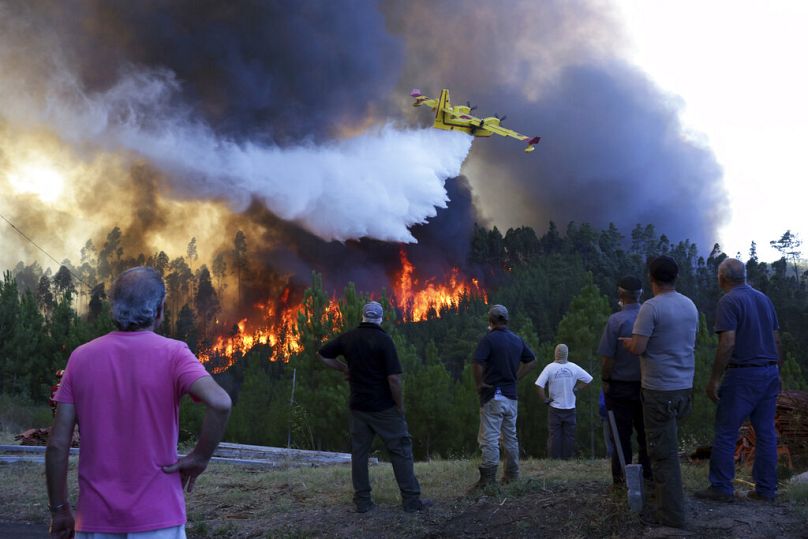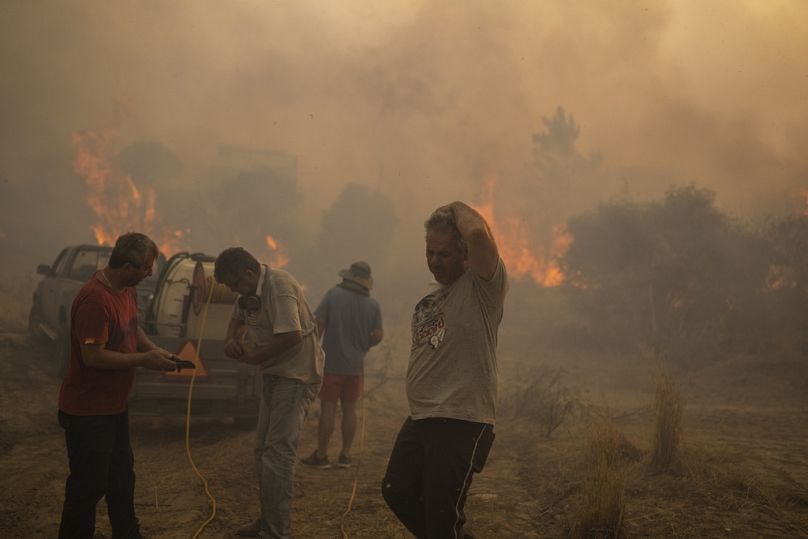Scientists are predicting longer-burning wildfires in future decades. As Greece and Italy hit new records, does Europe need a new fire prevention strategy?
Wildfires across the European Union have laid waste to approximately 260,000 hectares of land so far this year, damaging infrastructure, prompting evacuations, and displacing thousands of people.
Extreme heat and low rainfall in the Mediterranean Basin have made countries like Italy, Spain, Croatia, Tunisia, and Algeria, where there is lots of dry vegetation, particularly vulnerable.
Firefighters in Greece recently announced they were beginning to contain the spread of July's infernos but the forest fire season is far from over and scientists warn that wildfires will become more frequent as global warming worsens.
What do the experts say?
According to the European Forest Fire Information System, more than 52,000 hectares of land have been destroyed by wildfires in Greece so far this year. This figure has surpassed the yearly average of 43,500 hectares, calculated between 2006 and 2022.
Moving west across the Ionian Sea, wildfires are showing no sign of slowing down, Italy is soon expected to exceed its own yearly average of 52,200 hectares.
While these wildfires pose a huge threat to Europe's ecosystems they are also endangering human life.
Domingos Viegas is a Professor of Mechanical Engineering at the University of Coimbra in Portugal and also serves as the coordinator of FirEUisk - a pool of researchers and policy-makers from 38 international organisations - who are all trying to mitigate wildfire risk across Europe. Viegas told Euronews that more and more civilians are dying from wildfires and associated smoke inhalation.
"In Portugal, the number of victims who are civilians has increased, this number has overtaken the number of firefighters killed. So this is a problem," Viegas said.
In June 2017, at least 66 people died and 250 others were injured when forest fires burned through 24,000 hectares of land in Portugal's mountainous Pedrógão Grande region. Dozens of civilians were killed while trying to escape the flames in their cars.
Despite the lessons learned in Portugal, this year's wildfires in southern Europe have once again turned deadly; at least 40 people have died across the Mediterranean region so far.
Lindon Pronto, a senior expert at the European Forest Institute and a former firefighter explained why wildfire outbreaks are accelerating: "Fire behaviour is driven by three factors. One is the topography, one is the weather and the other is available fuel. So burnable material was traditionally vegetation but now infrastructure is serving as fuel".
So what is Europe doing to mitigate the risk of wildfires?
The European Commission announced last week it was going to purchase a fleet of 'Canadair' jets to boost Europe's firefighting capacity but these planes will not be ready until 2027.
"We can't keep just throwing money at the problem", Pronto added.
"We have to work from the ground up to raise awareness, we have to treat the landscape so it's less flammable. We have to educate people and create more value chains at a landscape level so that we're not having this fuel build-up when there are extreme fires, exacerbated by climate change."
The FirEUrisk project has completed a number of wildfire tests on so-called pilot sites to help Europe better contain wildfires.
The initiative has mapped every square kilometre of Europe based on its climate, landscape and socio-economic activities to make civilians and governing bodies more aware of wildfire risks.
Fuel modelling
Surveying vegetation was a huge part of this process, explained Viegas as highly flammable trees, particularly eucalyptus and pine varieties, heavily support the spread of fires and jeopardise the effectiveness of fewer fuel breaks. Peat bogs are also a problem as peat fires generate a lot of smoke and can burn for days weeks or even months if left unattended.
37.7 per cent of the EU's land area is made up of forests, many of which contain highly flammable trees, so how can heavily wooded countries reduce the risk of forest fires? According to Pronto, the key is to ensure that fires stay on the forest floor and don't spread to the crown of densely-wooded areas, where they are harder to suppress.
"In the short term, authorities can create firebreaks, buffer zones and ponds. There are all sorts of different tactics and strategies and also different contexts. Planters can also move away from these very flammable monocultures that we've seen in places like Portugal but that's the long-term strategy, changing the entire composition of a forest at a landscape level takes decades" he said.
While some countries in the EU, like Portugal, have developed strategies to manage wildfires, some Member States, particularly in the north of the European bloc, do not have any framework in place.
Together with government agencies, FirEUrisk is studying the effects of previous blazes and pushing for policy changes to help prevent wildfires in the future.
"We know that in Europe most fires are caused by human action, but some are also natural... so, we are also looking at the elements, for example, houses, infrastructure, and of course, the ecological value of nature and how it is exposed to fire," said Viegas.
So what can civilians, particularly in the south of Europe, do to protect themselves?
Change at a grassroots-level
According to Viegas, there are three things civilians living close to dry shrubland can do to protect their homes and each other.
1. Clearing vegetation from around the outside of one's property will help limit the fuel available to an oncoming fire.
"I am not saying you cannot have plants, but you need to keep some distance between the house and shrubbery.
"You have to keep the fuel load low, because otherwise your house, even if it is made of brick, could be in danger... and it could burn. So this is the first priority, ensuring the likelihood that people survive" said Viegas.
2. Staying at home to defend one's property instead of fleeing into the open is also important: "In southern Europe, we don't support mass evacuations like in North America, because in certain countries there are houses scattered everywhere," said the professor.
Evacuations, particularly of the elderly, tourists, children and other vulnerable groups should be completed hours in advance. Viegas warned that people should not evacuate at the last minute as they will be exposed to extreme temperatures, and large plumes of smoke and will have little to no protection from the flames.
"The worst thing you can do is flee by car or on foot because you will have no defence".
"Houses made of brick and stone, in principle provide good shelter. In addition, if a fire produces embers that land in one's house it is easier to suppress a few sparks than deal with an inferno later" said Viegas.
3. Planned fires not only help to prevent the build-up of weeds and debris but they also improve biodiversity and ensure healthy ecosystems. Prescribed burns can also help farmers manage the spread of parasites and reduce the biomass of invasive species.
Ash from the embers of prescribed burns also promotes the growth of certain plants and helps boost pH levels and nutrients in the soil. However, Viegas stressed that any planned burns for agricultural purposes must be well managed, communicated to the authorities and done under the appropriate conditions. His warning comes as Greece's senior climate crisis official on Friday reported that 667 recent fires across the country were caused by human activity.
"For many years, fire was seen as a bad thing. So it was suppressed. People started to exclude fire from the landscape.
"But it is necessary to bring fire back and it is also necessary for some ecological processes...if we don't use it, we will need to prepare for bigger problems, especially in countries where vegetation grows very fast, like in southern Europe, where there aren't the means to remove weeds mechanically or by hand" concluded Viegas.













